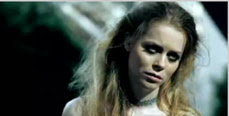'The Last Exorcism' teaser trailer explores the story of the possession of a teenage girl and her father’s fight for the soul of his daughter. The audience is introduced to this situation by the Reverend called on to perform the exorcism, the hook of the film is that although the exorcist has “performed over 50 exorcisms”, this is unlike anything he has ever seen. Its contextual relevance of this horror film comes from the use of a teenage main character and her demonic possession.
The teaser begins with the recognition of two institutions through the presence of idents. Lionsgate, Strike and Studio Canal are all featured, with usually only two used this is somewhat unconventional but suggests very high production values with three difference companies involved in fabrication.
The use of a conventionally attractive yet innocent looking main character features in both this trailer and in our own production. This is highlighted by the figures pale skin with little to no makeup, coupled with long, dark unstyled hair. The shots of these characters are also very similar, both represented through a facial close up. One slight difference is shot angle, this is interesting because of the characters’ very different role in each film. Where as in 'The Last Exorcism' this teenager becomes an object of demonic possession and therefore an antagonist, our production is the opposite. Our representation of an innocent girl is the idea of the ‘final girl’, a protagonist, the eventual survivor and eradicator of the demon. A high angled shot on the former is deceiving, convincing the audience of her apparent innocence. Our piece features a very slightly low angled shot on the character, demonstrating her power, though it may not be immediately apparent.
A use of weapon against a demon by protagonist is a common convention of horror films. In 'The Last Exorcism' this is fabrication through the use of a religious object, a crucifix, often thought to warn off the devil. This object suggests an idea that the possession is an on-going problem and there have been plans and preparations in order to deal with it. The use of a knife to protect a character against a demon suggests quite the opposite. This is a common household item that has more likely been grabbed in order at an attempt of self-preservation by the character. That lack of knowledge of the danger creates fear in the viewer.
In the trailer there is a short sample of the demon speaking through the possessed body, this is coupled with a close up very different to the shot we saw of the teenage girl earlier. She now appears someone completely different, no longer a sweet innocent girl but a brutal, bedraggled figure of evil. Her hair has been thrown over her face, suggesting she is on all four and has risen from the floor like an animal. This theme is continued through her stance with face tilted down, giving the feeling of a predator about to strike. One of own shots is comparable, a possession takes over as the character rolls her head, jolting from side to side.

Over the shoulder/close up shots of the character observes their possession in a mirror features in both productions. In 'The Last Exorcism' this is effectively achieved by a lack of focus on the actual character making her a background figure. The camera is actually focuses on the mirror itself and two crop ears laid against it; this creates fear because the threat cannot be properly evaluated because the audience is not allowed to see it clearly. The mirror itself is dirty, between this and the corn it suggests that she is in the family barn, in a rural area and therefore an idea of isolation. This isolation seems a lack of aid for other characters to protect themselves from this threat. Our own mirror shot demonstrates the effect physically of the demon on the character.
- Meg
Also see... The Last Exorcism Poster Deconstruction










































